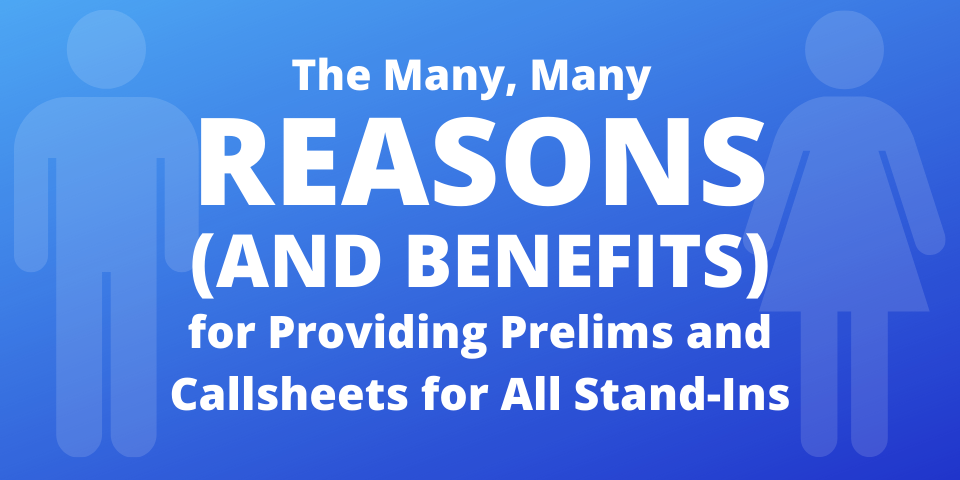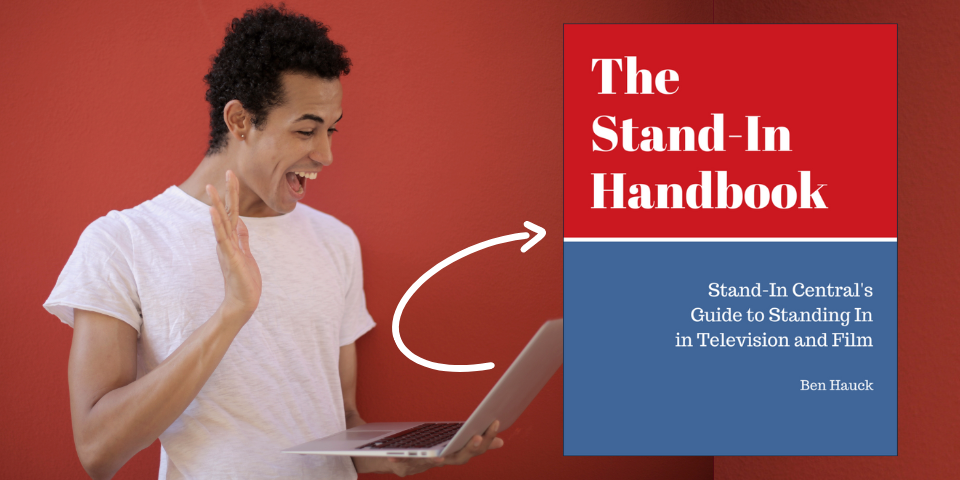Let’s face it: Most stand-ins report to work with little to no information about the day’s work ahead of them.
Stand-ins might show up to work knowing the height of the actor for whom they’re standing in (or not). They might know the actor’s name (or not). They might know whether the scenes in which they are involved are exteriors or interiors (or not). They might know the crew call time (or not). They might know how long they should anticipate working (probably not).
Relatively few stand-ins (namely those who are core stand-ins on a particular job) receive considerable information about the day’s work ahead of them. They might be on set one day and see the prelim for the projected work tomorrow (or not). They might be offered a prelim to see or keep (or not). They might be among the very few stand-ins who are emailed prelims and callsheets after wrap (or not).
The sad fact is that many stand-ins report to work, and are considered members of the crew, but as members of the crew, they are among the least informed about the day’s work, the storyline, or the production in general. This is through no fault of their own. Everyone else tends to know a lot more information about the job likely because they have received information either directly from production or from their team leads or department heads.
Yet many productions seem to exclude stand-ins from seeing prelim information or callsheets, overlook stand-ins’ interest in those documents, or sometimes outright bar stand-ins from seeing the information — or say to ask casting directors for that information. The reasoning for preventing stand-ins from seeing prelim and callsheet information is likely hard to argue in light of other production members’ having it. A production’s presumption that stand-ins would breach presumed or explicit confidentiality about the production if they had the callsheet information would reflect a discriminatory prejudice against stand-ins.
But if stand-ins were more automatically — even contractually — required to receive prelims and callsheets in advance of their day’s work, stand-ins would benefit from that information. And not just stand-ins would benefit. Productions would also benefit from providing prelims and callsheets to stand-ins. These benefits would be palpable to production, and if given to stand-ins and taken away, the absence of that information provided to stand-ins would also be palpable to production.
The general result of making the provision of prelims and callsheets to stand-ins de rigueur would be that for stand-ins truly interested in the workday ahead of them, they can make plans in order to do their job to the best of their ability, rather than find themselves unprepared for the work ahead of them.
Furthermore, stand-ins can better service their productions with that information; they can be more proactive than reactive to the job and its flux; and they can be less requiring the explicit direction of assistant directors who might feel burdened by having to track down and communicate each bit of information about the production day down to the stand-ins. If stand-ins were more informed, assistant directors can let off tracking down stand-ins or explaining them what is going on, and instead deal with the other, multiple demands that productions place on ADs.
Here are some of the many, many reasons for providing prelims and callsheets for all stand-ins. (They will be collectively referred to as “callsheets” or “callsheet information” below.) These many reasons are also many benefits both for stand-ins and production, which inevitably improve the worker experience on the job as well as the bottomline budgetary interests of production.
Stand-Ins Can Identify and Research Their Actors before Marking Rehearsal
If you are a day-playing stand-in on a production, you might have been hired to stand in for a day-playing actor. In other words, the actor for whom you’re standing in may be new to the production, so you might not know what he or she looks like. Or, you might simply not know the production at all, so even if the actor is a series regular or guest star, you might not recognize the actor.
If you were able to know the actor’s name ahead of marking rehearsal, you wouldn’t have to ask for which actor you’re standing in, especially if there are a lot of day-playing actors on set at the time. You presumably could figure it out, because with the actor’s name, you could research the actor ahead of your first time seeing him or her and see a photo. You could get a sense of not just what the actor looks like, but also his or her height (if reported), and also address any differences between you and the actor’s appearance. For example, if you are standing in for someone who is taller than you, and if you have lifts or taller shoes you can wear, knowing this information means you can proactively report to work with appropriate shoes or lifts, rather than have to react the moment you see your actor and discover your actor is taller.
Stand-ins having prelim and callsheet information about their actors helps stand-ins in this way. Casting directors hiring stand-ins do not always provide this information.
Stand-Ins Can Prepare with the Proper Gear before Reporting to Work
If a production is shooting exteriors, and if it is winter, you know that you might be outside for long periods of time when you are working, and you might even be required to stand relatively still in one place as opposed to keeping your blood moving.
While casting directors tend to provide information if a stand-in is shooting exteriors, that information is not always provided, and when it is provided, sometimes it is so general that it is unhelpful for the stand-in. For example, the callsheet may say that production is shooting exteriors and interiors scenes on the day, so the casting director simply tells all background actors and stand-ins working that day that they will be shooting “interiors and exteriors.” But if you see on the callsheet that your actor is in the only interior scene for the day, there is no particular need in most cases to bring the kind of stand-in coldweather gear that you would need were you to stand in outside in the cold all day.
Granted, you might see on the callsheet that there is a chance that production will double you up to stand in for another actor in an exterior scene, in which case you would want to bring your coldweather stand-in gear. Having the callsheet before you report to work would help you figure that out. A casting director usually won’t provide that level of specificity about your upcoming work. Plus, it may be logistically difficult for a casting director to do so.
Stand-Ins Can Mete out Their Energy for the Day
Many stand-ins work on several different productions, so they are continually jerked around in their schedules and sleep. One production might shoot until midnight, and the next job a stand-in might be on may have a calltime at 6am. Not knowing how much work to expect on the current day, and not knowing how much work to expect on the next day, means that the stand-in has a difficult time making decisions to optimize work.
For example, if a stand-in went into the current day knowing it could go until about midnight, he or she could be cautious about selecting work with early prelim calltimes the next day. If that stand-in had callsheet information for a job the next day, and if he or she saw the early calltime, that could mean any number of things. “Should I arrange a ride home or stay at a crash pad?” “Should I get in a workout before work, or will I have time after work?” “Should I skip breakfast or coffee at home, or should I make sure to get them before reporting to work?”
Productions can be demanding on stand-ins, and those demands can be lifted considerably by providing stand-ins with callsheet information. Without that information, stand-ins have a harder time than other crew members in making decisions over their lives and livelihoods. With that information, they can make more optimal decisions in their lives, which inevitably mean a more useful and productive worker on set.
Stand-Ins Can Anticipate What Is Next for Production
As mentioned earlier, stand-ins who know what’s going on won’t burden assistant directors as much as those who have no idea what is going on on set today.
With callsheet information, stand-ins can figure out a number of key bits of information that help them be better able to respond to changes in scenes, studios, and locations, as well as understand projected start times and wrap times. Much of the time, stand-ins can figure out from callsheets:
- Changes in locations (stages, studios, company moves, etc.)
- Anticipated start times for working on scenes (gleaned from actors’ anticipated rehearsal times, if posted)
- Anticipated wrap times (based on a number of factors contained on the callsheet, including the number of scenes, the sunup/sundown times, the work scheduled for tomorrow, etc.)
- Whether a stand-in might be working longer or shorter hours tomorrow, or not at all (based on whether production wants to double-up a stand-in to stand in for more than one actor, have separate stand-ins, or new stand-ins entirely)
- Whether an actor has any more days on the production, or is done shooting with the current day
- Where production will be the next days (as shown on the advance schedule at the bottom of callsheets)
- etc.
With all of this information, stand-ins can make decisions and preparations in their lives and also decisions and preparations on set where they are working. They can prepare for a change in locations (rather than simply react to a change). They can anticipate the lengths of their days (especially when stand-ins need to find precious times for things going on in their own lives). They can anticipate whether they should keep open for production to hire them for more days or simply seek different work.
These benefits, among others, are palpable for a production who is interested in having solid stand-ins.
Generally, Stand-Ins Are More Informed with Callsheet Information
When you have stand-ins who are informed about the production through inclusion in the callsheet information, in general, the production will reap the benefit.
The stand-ins will tend to take more interest in the production and those involved in making it when they are offered callsheet information rather than excluded from it. They will feel more like team players rather than outcasts or lesser workers on the job. They will “check in” to the production more, rather than “check out” because of having to wait for information to be learned through hearsay, rumor, and the like. And they will be more on the same page with the crew members who need to closely interact with stand-ins, because stand-ins will know what is going on in a production rather than have to be told.
Of Course, There Are More Benefits
Surely, this article doesn’t list all of the benefits of getting all stand-ins prelims and callsheet information as a matter of standard practice. There are likely plenty more to be discovered. But above are definitely some considerable ones. Crew members benefit from callsheet information, as it allows them to prepare for their work and speed along production. So should stand-ins.
What other reasons should stand-ins receive prelims and callsheets? What other benefits can stand-ins and production reap from providing that information to stand-ins? Share your opinions below!







Leave A Comment